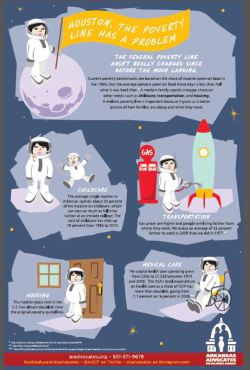
Poverty guidelines play two important roles, they are a scorecard for how we are doing as a state, and they help determine eligibility for dozens of programs that low-income Arkansans rely on.[i] Because the current guidelines are outdated, they fail to give us the most accurate representation of actual poverty levels in our state, and they may be disqualifying needy Arkansans from the programs that make our state stronger.
This new AACF infographic illustrates our point.
The current poverty benchmarks in the United States are based on decades-old research. In the 1960s, the average family of three spent about a third of their after-tax income on food, so the poverty line was set at about three times the cost of the cheapest food plan from the Department of Agriculture.[ii] This way, a family could afford a nutritional diet by spending no more than a third of their income on food. In 1965, this calculation was officially adopted by the Office of Economic Opportunity as the standard measure of poverty, and it hasn’t fundamentally changed since.[iii] This guideline for poverty, which was implemented almost half a century ago, has only been updated to account for inflation. The federal poverty line for a family of four is only $23,850 a year.
Although the adequacy of the current poverty benchmarks has been the subject of much debate over the years, there have been no changes to the official poverty line. One of the criticisms of the current poverty line is that families don’t spend a third of our paychecks on food anymore. Researchers at MIT show that a single parent of two in Arkansas earning a living wage should anticipate budgeting only about 17 percent of their income on food, not 33 percent like in the 1960s.[iv] In fact, food costs don’t even make the top three expenses in this budget. That same parent should plan to spend about 20 percent of their income on childcare, 20 percent on transportation, and another 20 percent on housing. In addition to the MIT study, various studies over the years have found that it takes a wage that is significantly higher than the minimum wage or poverty line wages to really meet all of the basic needs of families. You can read a previous report by AACF here.
Childcare and housing are essential for Arkansas families, and their costs have all gone way up in recent decades. The cost of childcare has shot up, increasing 70 percent from 1985 to 2010, even after adjusting for inflation. In Arkansas the average single mother pays about 30 percent of her annual income on childcare, which can cost almost as much as full time tuition at an in state college. Housing is another expense not captured by the federal poverty guidelines that is taking a huge bite out of low income families’ budgets. In the 40 years after the implementation of the poverty guidelines, the median gross rent in the United States almost doubled.[v] If the poverty guidelines are based of food costs, they just aren’t a realistic representation of what it currently costs to make ends meet.
Eligibility for these programs is based on the poverty guidelines: [vi]
- Department of Health and Human Services:
- Community Services Block Grant
- Head Start
- Low-Income Home Energy Assistance Program (LIHEAP)
- PARTS of Medicaid
- Hill-Burton Uncompensated Services Program
- AIDS Drug Assistance Program
- Children’s Health Insurance Program
- Medicare – Prescription Drug Coverage (subsidized portion only)
- Community Health Centers
- Migrant Health Centers
- Family Planning Services
- Health Professions Student Loans – Loans for Disadvantaged Students
- Health Careers Opportunity Program
- Scholarships for Health Professions Students from Disadvantaged Backgrounds
- Job Opportunities for Low-Income Individuals
- Assets for Independence Demonstration Program
- Department of Agriculture:
- Supplemental Nutrition Assistance Program (SNAP) (formerly Food Stamp Program)
- Special Supplemental Nutrition Program for Women, Infants, and Children (WIC)
- National School Lunch Program (for free and reduced-price meals only)
- School Breakfast Program (for free and reduced-price meals only)
- Child and Adult Care Food Program (for free and reduced-price meals only)
- Expanded Food and Nutrition Education Program
- Department of Energy:
- Weatherization Assistance for Low-Income Persons
- Department of Labor:
- Job Corps
- National Farmworker Jobs Program
- Senior Community Service Employment Program
- Workforce Investment Act Youth Activities
- Department of the Treasury:
- Low-Income Taxpayer Clinics
- Corporation for National and Community Service:
- Foster Grandparent Program
- Senior Companion Program
- Legal Services Corporation:
- Legal Services for the Poor
[i] There are two major poverty measurements in use today. The first, Poverty Thresholds, are used to track statistical changes in the prevalence of poverty. The second, and very similar, Poverty Guidelines are a simplified version of the poverty threshold used to determine eligibility for certain programs.
[ii] https://aspe.hhs.gov/poverty/faq.cfm
[iii] https://www.nytimes.com/2007/04/17/us/17orshansky.html?_r=0
[iv] https://livingwage.mit.edu/states/05
[v] https://www.census.gov/housing/census/data/grossrents/grossrents_adj.txt
[vi] https://www.irp.wisc.edu/faqs/faq1.htm
